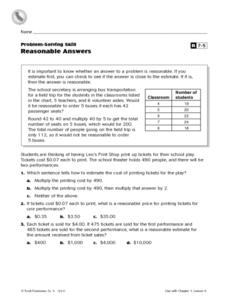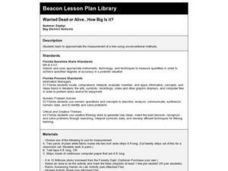Curated OER
American Quilts
Third graders demonstrate the ability to make an emotional connection to A Quilt Story.
Curated OER
Proportionality Using Wind in the Willows
Students examine proportionality in Wind in the Willows by comparing Mr. Toad, objects proportional to him and objects proportional to humans. They then measure a stuffed Mr. Toad and make common objects proportional to Mr. Toad???s...
Curated OER
Problem Solving Skill: Reasonable Answers
In this problem solving worksheet, students read a story problem on the cost of fabric and then answer 4 fill in the blank problems regarding the price of fabric and whether or not it is reasonable.
Curated OER
Quilting with Middle School Students: Using Proportionality to Develop Quilt Designs
Students use quilt patterns to illustrate ratios. For this fractions lesson, students color quilt patterns using given fractions and ratios of colors. A finished "quilt" is assembled from the work of the students. This is an...
Creative Educator
Dream Room Design
Using the Twist™ application, elementary schoolers design their dream room. They follow the prescribed steps to calculate width, length, perimeter, and surface area in order to create a 2-dimensional representation of their dream room...
Curated OER
Teddy Bears Everywhere
Students explore the history of teddy bears. In this comprehension lesson, students bring a bear of their own to compare and contrast with their classmates. Students read book and discuss the events and draw pictures of the scenes.
Curated OER
The Air Up There
In this data collection and analysis lesson plan, students observe and graph the weather conditions during one school week, then calculate the average weather temperature. Extensions are included.
Curated OER
Shopping Spree
Students calculate discounts, sale price, and sale tax. In this consumer math lesson plan, students visit mock stores which have items for sale. Students calculate the final prices of items.
Curated OER
The Expenditure Sheet
Students differentiate between expenditure and income. In this algebra activity, students create a spreadsheet labeling the date, item and amount as they track their expenses. They format the cells of the spreadsheet to do all the...
Curated OER
Classmate Grid
Students interview classmates and record their findings on a coordinate grid using Inspiration or Kidspiration and digital cameras. This lesson is technology-based and includes resource links.
Curated OER
Using Math with Sale Papers
Fifth graders estimate their results and then prove through calculations. In this math lesson, 5th graders solve problems using multiplication, division, addition, and subtraction. They also use mental math to solve their problems.
Curated OER
Oobleck
Students incorporate within this lesson scientific observations, senses: touch, sound, smell and sight, classification, states of matter and surface tension. Students make a substance and use scientific observations, as well as their...
Curated OER
Applications Of Rational Functions
Students engage in a lesson plan that is about relational functions with the application of methods to real life problem situations. They use the examples found in the lesson plan for the purpose of practice during guided instruction....
Curated OER
Problem Solving
In this problem solving worksheet, students read story problems, set up the equations and determine the answer to the problem. They use words to justify their reasoning. This two-page worksheet contains 5 problems involving proportions.
Curated OER
Building a Native American Home
First graders explore different types of Native American shelters. In this Native American homes lesson, 1st graders compare the shapes of shelters used by Native Americans. They build a home using the program "Community Construction...
Curated OER
Counting Principle
Students identify the different outcomes given a situation. In this algebra lesson, students calculate the possible outcome using the counting principle. They compare and analyze patterns to make their predictions.
Curated OER
Making Graphs
Students explore statistics by conducting class demographic surveys. In this graph making lesson, students identify the family members of each classmate, pets they own, and favorite activities. Students organize their statistics and...
Curated OER
Wanted Dead or Alive...How Big Is it?
Fourth graders estimate the measurements of trees using unconventional techniques.
Curated OER
Measurement, Perimeter and Area
Learners explore the concept of measurement. In this measurement lesson, students collect data about themselves such as height, finger length, neck circumference, foot length, and other body measurements. Learners cut squares of...
Curated OER
Graph and Compare the Adventure's Temperature Vs. Local Temperature
Students explore the concept graphing data. In this graphing data activity, students use weather data from their local weather and some other city and graph them. Students plot the local weather vs. another city. Students record...
Curated OER
Flying Geese
Students examine the Flying Geese quilt pattern, and discuss and identify the pattern. They write a paragraph titled, My Quilt Report, summarizing the information discussed about the quilt patterns.
Curated OER
Candy Land Math
Students order numbers and sets of objects from 0 through 10 and organize and interpret information collected from the immediate environment. They read and interpret graphs usin real objects and the computer. Finally, students sort a...























